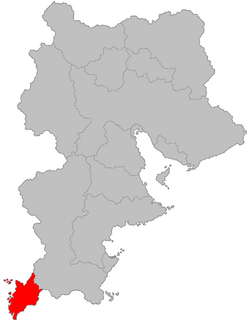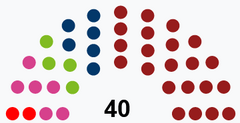Tarpeia
State of Tarpeia
| |
|---|---|
| Motto: Concordia Apostolum | |
| Anthem: Inno del Mare Hymn of the Sea | |
 | |
| Country | Etruria |
| Status | Constituent state within a Federation |
| Annexation in Etruria | 1962 |
| Autonomous Region | 1963 |
| Constituent State | 1979 |
| Capital | Centuripe |
| Government | |
| • Type | Parliamentary republic in a federation |
| • Body | State Assembly |
| • Prefect of State | Nero Orlando (MT) |
| • Deputy Prefect | Serafina Galvagno (MT) |
| Population (2020) | |
| • Total | 1,700,655 |
| Demonym | Ruttish |
| GDP | |
| • Total | $ million |
| • Per capita | $ |
| Area code | +101 |
| Official languages | Vespasian Novalian |
| Patron saint | Saint Paul |
Tarpeia is a state located in southwestern Etruria. It is bordered to the west by the Acheolian Sea, to the north by the country of Piraea, to the east and northeast by the state of Novalia, and to the south by XX. Due to its geographical shape and its Acheolian coast line, it is also known as the Tarpeian Corridor (Corridoio Tarpea). With a total land area of XX,XXX it is the Xth largest state in Etruria, and with a population of 1.7 million it is the 12th most populous state in Etruria. It's capital and largest city is Ghiutrave, other major cities of the state include Scaccianari and San Pietro supra Giove.
The region of modern day Tarpeia was inhabitated by predominately a variety of Samnii tribes, before being colonised by Ancient Piraea, who brought with them Piraean culture, language, religion and virtues. Through the Piraean presence in Tarpeia and to the east in Etruria proper, the Solarian civilisation drew considerable influences. The region remained under Piraean control for much of 2nd century BC, until expansion by the Solarian Republic saw it, alongside Piraea itself be conquered. Under Solarian dominion, the region rapidly grew in population as the Republic exploited the vast deposits of tin and copper, while its fertile soil was used to feed the rapidly growing city of Solaria. To support these materials and goods being consumed by the city, the Republic constructed the Via Acheulia, connecting the port city of Camerium with Solaria, bisecting modern-day Tarpeia. In 83 BC, the region was absorbed into the politico-religious boundary known as the Maius Pomerium, which denoted the territory to governed directly by the Senate. In 132 AD, the area directly east of Scaccianari, was the site of the Battle of Scianarium, one of the largest slave revolts in Solarian history.
During the late Imperial Period (300-435 AD), the region was invaded and settled by a variety of Marolevic tribes who migrated from the west. Among these settling tribes were those who would go on to form the ethnic Novalians and Miruvians, while the collapse of Imperial authority also saw the return of Piraeans to the region. Following the collapse of the Solarian Empire in 435 AD, the region fractured into various tribal polities until the rise of the First Piraean Empire, which it was formally annxed in 1085. In the early 12th century, coastal Tarpeia was seized by the Most Exalted Republic of Povelia and would remain under Povelian control until the 18th century. Under Povelian dominion, the ports and harbours of the coast were utilised for Povelian trade with Amathia and Soravia, with Ghiutrave emerging as the largest and wealthiest of the trade cities. During the 14th and 15th centuries, the coast was regularly raided by Satrian corsairs and Pardarian pirates, until the Povelian navy crushed piracy during the Wars of the Sea (1420-1438).
In 1749, the region was conquered by the Grand Principality of Alikianos following the Tarpeian War (1747-1749), but would fall under control of the First Etrurian Republic in 1788 during the First Etrurian Revolutionary War. This marked the beginning of Tarpeia's association with the united Etrurian polity. The Etrurian Republic used Tarpeia as a springboard to invade southern Piraea, while Ghiutrave was rapildy developed to provide shelter and supplies as a naval anchorage. Much of coastal Tarpeia would return to Piraean control, with the area including Scaccianari would be absorbed into the United Kingdom of Etruria in 1810. This area, having been de-populated during the Revolutionary Wars, was settled by predominately Novalians at the behest of the Etrurian monarchy, while the ethnic Vespasians along the coast became increasingly nationalistic and yearned for reunification. The areas under Piraean control, saw dramatic shifts in demography, as thousands of Piraeans were mandated to settle in rural and urban areas.
Tarpeia was the first region to be attacked by Etrurian forces during the Great War, which the Etrurian 2nd Army seizing Ghiutrave in late 1927, this was followed by the subsequent invasion of Piraea itself by Etruria owing to the former's alliance with Functionalist Gaullica. Following the end of the Great War, Tarpeia in its entirety returned to Etrurian control and rapidly, rights and freedoms were denied to the sizeable Piraean population. In 1938, the Legionary Reaction resulted in the establishment of the Greater Solarian Republic, which instituted the Etrurianisation of Tarpeia, this involved the forced displacement of ethnic Piraeans out of the cities and towns, the renaming of settlements and then ultimately, a ban on the speaking and writing of Piraean. With the outbreak of the Solarian War in 1943, the Etrurianisation process escalated into the massacring of ethnic Piraeans and their deportation to Piraea. An estimated 90,000 Piraean civilians were killed during the eight-year period, though with the defeat of the GSR in 1946, a majority of Tarpeia returned to Piraean control under the Treaty of Ashcombe.
From 1946 until 1960, the region was governed under the First Piraean Republic and became a hotbed for both, far-left politics and that of the far-right. It became a safe haven for many prominent Novalian left-wing nationalists, who used Tarpeia as a base to stir nationalist sentiments in Novalia in the aim of securing an independent socialist republic, while ethnic Vespasians regularly agitated for reunification with Etruria and instigated protests and low-level terrorist activity against Piraean authorities. In 1960, Etruria's Third Republic was overthrown by the military who established a military regime, ostensibly in response to the growing Western Emergency. Citing the sanctuary provided to enemies of the state, the Etrurian military government launched a full-scale invasion of Tarpeia and the Aprocorona Islands, seizing the territory from Piraea with little to no resistance. The region was proclaimed a Federal Autonomous Region in 1963, Tarpeia would remain under military occupation until 1979, when it was formally admitted into the Etrurian Federation as a state. Since 1960, the region has witnessed significant investments by the Etrurian government, becoming one of the most productive agricultural regions in Etruria. Coastal Tarpeia has also become a major tourist destination and home to a sizeable expat population drawn from across Euclea.
History
Geography
Climate
Politics and government
 |
|
Government (22) Tribune Movement (22) Confidence and supply (6) Workers and Farmers Union (6) People's Opposition (12) Social Democratic Party (6) Liberty Party of Tarpeia (4) PR (2) |
The political order and governance of Tarpeia is defined by the Constitution of Tarpeia, which acts as the basic law of the state and provides guaranteed rights and freedoms for the citizens of the state. Like all states in Etruria, Tarpeia operates a parliamentary republican system, with the executive branch dependenant upon the confidence of the legislative, while the judicial branch is separate and independent.
The government of Tarpeia is led by the Prefect of State, who is the leader of the largest party or coalition in the State Assembly. The Prefect upon securing office appoints members of the Assembly to form his or her state cabinet, as well as Deputy Prefect of State. The State Assembly of Tarpeia has 40 members who are elected from single-member constituencies every five or four years, while the Prefect has the right to dissolve the State Assembly upon securing permission from the President of the Federation. The incumbent Prefect of State is Nero Orlando, who entered office following the 2018 Tarpeian state election, his deputy is Serafina Golvagno.
Florida has 67 counties. Some reference materials may show only 66 because Duval County is consolidated with the City of Jacksonville. There are 379 cities in Florida (out of 411) that report regularly to the Florida Department of Revenue, but there are other incorporated municipalities that do not. The state government's primary revenue source is sales tax. Florida does not impose a personal income tax. The primary revenue source for cities and counties is property tax; unpaid taxes are subject to tax sales, which are held (at the county level) in May and (due to the extensive use of online bidding sites) are highly popular.
In the 2018 state election, the electoral system was changed to first past the post system, resulting in a majority of one for the Tribune Movement, though they secured a confidence and supply agreement with the Farmers and Workers Union, with their six seats. The main opposition party in Tarpeia is the Social Democratic Party, while the Liberal Party of Tarpeia and far-left Popular Renewal constitute the minor opposition.



